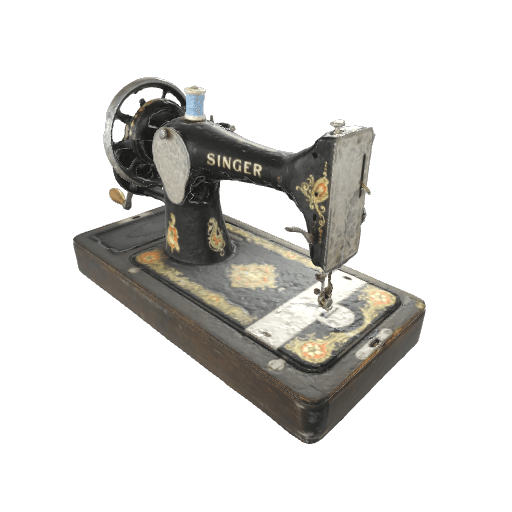Sewing machine
This mechanical Singer model 128 machine is made of black enamelled cast iron with gold or pearly ornaments (a design called the vencedora). Compact and light, this wooden-base-mounted machine can be carried and used on any work surface. It is hand-operated by a small crank attached to the wheel. It can also be inserted into a sewing machine table, where it is operated by a pedal.
The sewing machine is an essential object in households. It allows the repair and the making of clothes directly at home. Sellers market it to domestic use, specifically to women and housewives. Since these items are expensive, the Singer company offers the possibility to buy its products in instalments or on credit, a commercial innovation for the time. The advent of the sewing machine contributed to the development of the home sewing profession, as well as the repair and sale of sewing machines.
The first sewing machine model was first patented in Paris in 1829, by Barthélémy Thimonnier. Thanks to the improvements made by other inventors, including Isaac Nerritt Singer, the founder of the Singer Company, the sewing machine is later marketed on a large scale.
Founded in 1851 in New York, the Singer Co. was one of the largest sewing machine companies in the world. At the time, it was ahead of its competitors with the invention of a shuttle mechanism with a one-eyed needle. This innovation allowed the machine to produce a stronger two-thread lockstitch. The Singer model 128 goes into production in 1912 and will be manufactured until 1962, selling several million machines. In 1921, Singer introduces the first electric sewing machine models to the market.
The Singer company established several factories in Quebec, notably in Montreal and Saint-Jean-sur-Richelieu. Singer retail stores were opened in most cities in the world, including Rimouski.
References
Date: 1923–1962
Origin: North America
Owner: Magasin général historique authentique 1928. Percé.
Sources:
Digital Museums Canada. (n.d.). De fil en aiguille: la compagnie Singer à Saint-Jean-sur-Richelieu [From thread to needle: the Singer company in Saint-Jean-sur-Richelieu]. Musée du Haut-Richelieu. Retrieved August 10, 2022, from https://www.histoiresdecheznous.ca/v1/pm_v2.php?id=record_detail&fl=0&lg=Francais&ex=00000395&hs=0&rd=100747
Puech, C. (2017, March 16). Histoire de la machine à coudre [History of the sewing machine]. Le Blog Gallica. https://gallica.bnf.fr/blog/16032017/histoire-de-la-machine-coudre?mode=desktop#:~:text=En%201851%2C%20Singer%20met%20au,avait%20pas%20d%C3%A9pos%C3%A9%20de%20brevet
Marchand, S. (1988). L’impact des innovations technologiques sur la vie quotidienne des Québécoises du début du XXe siècle (1910–1940) [The impact of technological revolutions on the daily lives of Quebec’s women in the early 20th century (1910–1940)]. Revue d’histoire matérielle, 28, 1–14. https://dai.mun.ca/PDFs/cbu/Bulletin28.pdf
James, V. (n.d.) Singer Sewing Machine no 127 and 128: Value, History, Review. Sewing is Cool. Retrieved April 16, 2022, from https://sewingiscool.com/singer-sewing-machine-no-127-and-128-value/
Singer. (n.d.). History. Retrieved April 17, 2022, from https://www.singer.com/en-ca/history
